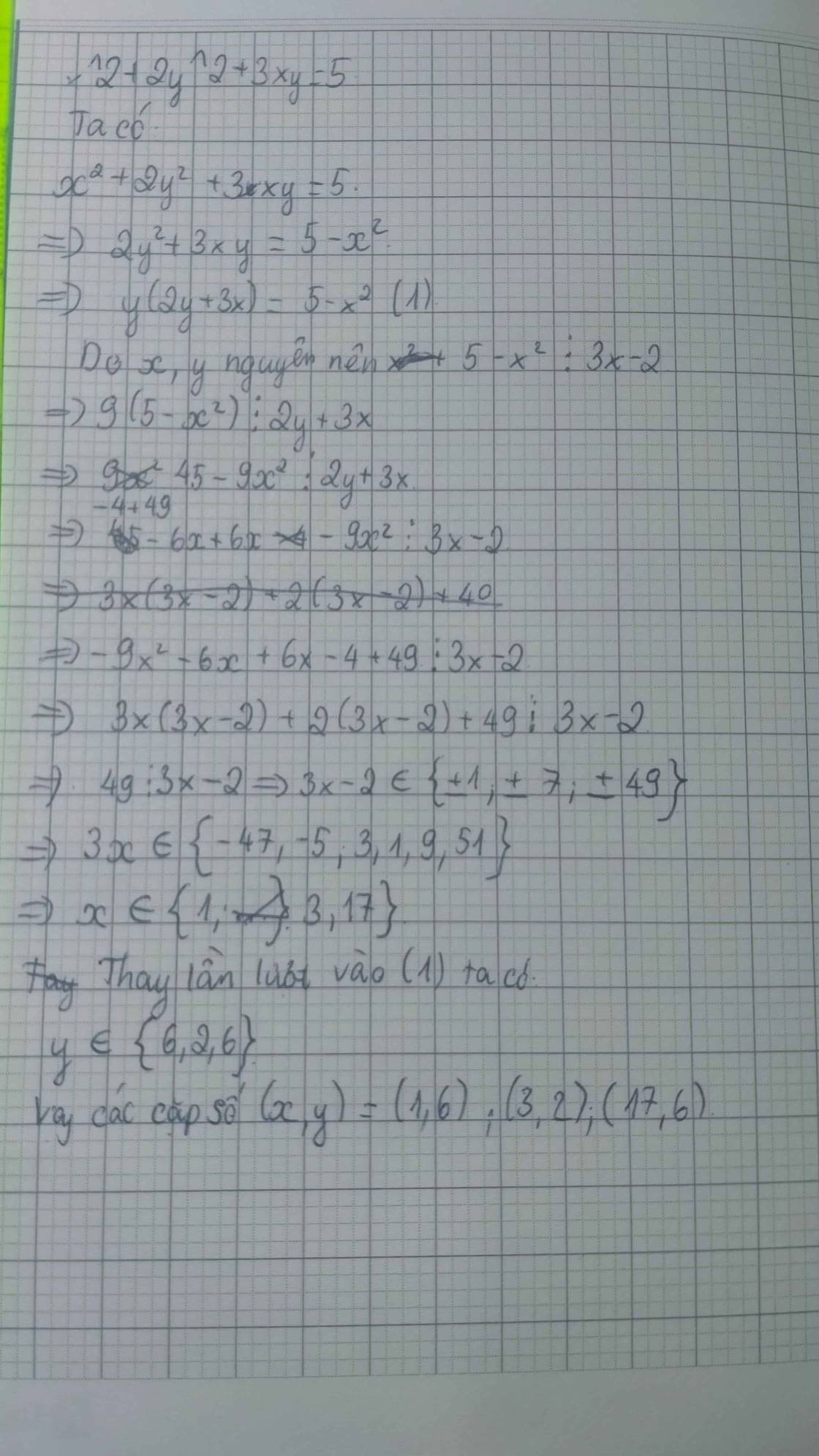
Hãy nhập câu hỏi của bạn vào đây, nếu là tài khoản VIP, bạn sẽ được ưu tiên trả lời.


\(x^2+2y^2+3xy-2x-4y+3=0\)
\(\Leftrightarrow\left(x+2y\right)\left(x+y-2\right)=-3\)

ta có pt
<=>\(x^2+xy+2y^2+2xy-\left(x+y\right)+3=0\)
<=>\(x\left(x+y\right)+2y\left(x+y\right)-\left(x+y\right)=-3\)
<=>\(\left(x+y\right)\left(x+2y-1\right)=-3\)
đến đây thì xét nghiệm nguyên của 3 và tự giải nhé !
^_^

Ta có : \(2x^2+y^2+3xy+3x+2y+2=0\)
\(\Leftrightarrow y^2+y\left(3x+2\right)+2x^2+3x+2=0\)
Nhận thấy pt trên là phương trình bậc hai ẩn y . Do đó ta xét
\(\Delta=\left(3x+2\right)^2-4\left(2x^2+3x+2\right)=x^2-4\)
Để pt có nghiệm thì \(\Delta\ge0\Rightarrow x^2-4\ge0\) \(\Rightarrow\left[\begin{array}{nghiempt}x\ge2\\x\le-2\end{array}\right.\)
Mà x,y là nghiệm nguyên của pt nên \(x^2-4\) là bình phương của một số hữu tỉ , đặt \(x^2-4=k^2\Rightarrow\left(x-k\right)\left(x+k\right)=4\) . Ta luôn có x + k > x - k với k > 0
Xét các trường hợp với x-k và x+k là các số nguyên được
\(\begin{cases}x=2\\k=0\end{cases}\) và \(\begin{cases}x=-2\\k=0\end{cases}\)
Suy ra được : \(\begin{cases}x=-2\\y=2\end{cases}\) và \(\begin{cases}x=2\\y=-4\end{cases}\)


2x2 + y2 + 3xy + 3x + 2y + 2 = 0
<=> 8x2 + 4y2 + 12xy + 12x + 8y + 8 = 0
<=> (4y2 + 12xy + 9x2) + 4(3x + 2y) + 4 - x2 + 4 = 0
<=> (3x + 2y + 2)2 - x2 = -4
<=> (3x + 2y + 2 - x)(3x + 2y + 2 + x) = -4
<=> (2x + 2y + 2)(4x + 2y + 2) = -4
<=> (x + y + 1)(2x + y + 1) = -1
Xét các TH xảy ra <=>
\(\hept{\begin{cases}x+y+1=1\\2x+y+1=-1\end{cases}}\)
\(\hept{\begin{cases}x+y+1=-1\\2x+y+1=1\end{cases}}\)
(tự tính)
Ta có: \(2x^2+y^2+3xy+3x+2y+2=0\)
\(\Leftrightarrow y^2+y.\left(3x+2\right)+2x^2+3x+2=0\)
Nhận thấy pt trên là phương trình bậc hai ẩn y. Do đó ta xét :
\(\Delta=\left(3x+2\right)^2-4\left(2x^2+3x+2\right)=x^2-4\)
Để pt có nghiệm thì \(\Delta\ge0\)\(\Rightarrow\)\(x^2-4\ge0\)\(\Rightarrow\)\(\orbr{\begin{cases}x\ge2\\x\le-2\end{cases}}\)
Mà x,y là nghiệm nguyên của pt nên \(x^2-4\) là bình phương của một số hữu tỉ
Đặt \(x^2-4=k^2\)\(\Rightarrow\)\(\left(x-k\right).\left(x+k\right)=4\)
Ta luôn có \(x+k>x-k\) với \(k>0\)
Xét các trường hợp với \(x-k\)và \(x+k\)là các số nguyên được
\(\hept{\begin{cases}x=2\\k=0\end{cases}}\)và \(\hept{\begin{cases}x=-2\\k=0\end{cases}}\)
Suy ra được \(\hept{\begin{cases}x=-2\\y=2\end{cases}}\)và \(\hept{\begin{cases}x=2\\y=-4\end{cases}}\)
Học tốt

Ta có:
x2 + 2y2 + 3xy + 3x + 5y = 15
<=> x2 + 2y2 + 3xy + 3x + 5y + 2 = 17
<=> (x2 + xy + 2x) + (2xy + 2y2 + 4y) + (x + y + 2) = 17
<=> (x + y + 2)(x + 2y + 1) = 17
=> (x + y + 2, x + 2y + 1) = (1,17; 17,1; - 1,-17; -17,-1)
Giải ra là tìm được x,y nhé

\(x^2+2y^2+3xy=5\)
=>\(x^2+xy+2xy+2y^2=5\)
=>\(x\left(x+y\right)+2y\left(x+y\right)=5\)
=>\(\left(x+y\right)\left(x+2y\right)=5\)
=>\(\left(x+y\right)\left(x+2y\right)=1\cdot5=5\cdot1=\left(-1\right)\cdot\left(-5\right)=\left(-5\right)\cdot\left(-1\right)\)
TH1: \(\left\{{}\begin{matrix}x+y=1\\x+2y=5\end{matrix}\right.\)
=>\(\left\{{}\begin{matrix}x+y-x-2y=1-5=-4\\x+y=1\end{matrix}\right.\)
=>\(\left\{{}\begin{matrix}-y=-4\\x+y=1\end{matrix}\right.\Leftrightarrow\left\{{}\begin{matrix}y=4\\x=1-y=1-4=-3\end{matrix}\right.\)
TH2: \(\left\{{}\begin{matrix}x+y=5\\x+2y=1\end{matrix}\right.\)
=>\(\left\{{}\begin{matrix}x+y-x-2y=5-1\\x+y=5\end{matrix}\right.\)
=>\(\left\{{}\begin{matrix}-y=4\\x+y=5\end{matrix}\right.\Leftrightarrow\left\{{}\begin{matrix}y=-4\\x=5-y=5-\left(-4\right)=9\end{matrix}\right.\)
TH3: \(\left\{{}\begin{matrix}x+y=-1\\x+2y=-5\end{matrix}\right.\)
=>\(\left\{{}\begin{matrix}x+y-x-2y=-1-\left(-5\right)\\x+2y=-5\end{matrix}\right.\)
=>\(\left\{{}\begin{matrix}-y=-1+5=4\\x+2y=-5\end{matrix}\right.\)
=>\(\left\{{}\begin{matrix}y=-4\\x=-5-2y=-5-2\cdot\left(-4\right)=-5+8=3\end{matrix}\right.\)
TH4: \(\left\{{}\begin{matrix}x+y=-5\\x+2y=-1\end{matrix}\right.\)
=>\(\left\{{}\begin{matrix}x+y-x-2y=-5-\left(-1\right)\\x+y=-5\end{matrix}\right.\)
=>\(\left\{{}\begin{matrix}-y=-5+1=-4\\x+y=-5\end{matrix}\right.\)
=>\(\left\{{}\begin{matrix}y=4\\x=-5-y=-5-4=-9\end{matrix}\right.\)

\(2\left(x+y\right)+1=3xy\)
=>\(2x+2y-3xy=1\)
=>\(x\left(-3y+2\right)+2y=1\)
=>\(-x\left(3y-2\right)+2y-\dfrac{4}{3}=-\dfrac{1}{3}\)
=>\(-3x\left(y-\dfrac{2}{3}\right)+2\left(y-\dfrac{2}{3}\right)=-\dfrac{1}{3}\)
=>\(-3x\left(3y-2\right)+2\left(3y-2\right)=-1\)
=>\(\left(3y-2\right)\left(-3x+2\right)=-1\)
=>\(\left(3x-2\right)\left(3y-2\right)=1\)
=>\(\left(3x-2;3y-2\right)\in\left\{\left(1;1\right);\left(-1;-1\right)\right\}\)
=>\(\left(x,y\right)\in\left\{\left(1;1\right);\left(\dfrac{1}{3};\dfrac{1}{3}\right)\right\}\)
mà x,y nguyên
nên (x,y)=(1;1)

Pt <=> \(x^2-2xy-xy+2y^2=-6\)
<=> x( x - 2y) - y ( x - 2y) = -6
<=> ( x - 2y) ( x - y) = - 6 = -3 .2 = -2. 3= -6.1 = -1.6
Vì x; y là số tự nhiên => 2y > y => x - 2y<0 < x - y
=> Có các TH sau:
Th1: x - 2y = - 3 và x - y = 2 <=> y = 5 và x = 7
Th2: x - 2y =- 2 và x - y = 3 <=> x = 8; y = 5
Th3:...
Th4:...

\(x^2+2y^2+3xy-x-y+3=0\)
\(\Leftrightarrow\left(x+y\right)\left(x+2y-1\right)=-3\)